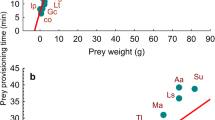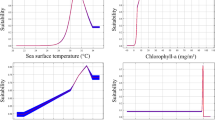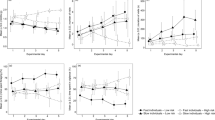Abstract
OPTIMAL foraging theory1–5 is based on the supposition that animals have been designed, by natural selection, to behave in a way that will maximise their inclusive fitness and that in terms of foraging this goal may be approximated by maximising the net rate of energy intake while feeding1–4. Therefore, given the constraints of any particular situation it is possible to predict how an animal ought to behave while foraging. I have tested an optimal foraging model which predicts how a predator should exploit patchily distributed prey. The results are consistent with the predictions of the model.
This is a preview of subscription content, access via your institution
Access options
Subscribe to this journal
Receive 51 print issues and online access
$199.00 per year
only $3.90 per issue
Buy this article
- Purchase on Springer Link
- Instant access to full article PDF
Prices may be subject to local taxes which are calculated during checkout
Similar content being viewed by others
References
MacArthur, R. H. & Pianka, E. R. Am. Nat. 100, 603–609 (1966).
Emlen, J. M. Am. Nat. 100, 611–617 (1966).
Schoener, T. W. A. Rev. Ecol. Sys. 2, 369–404 (1971).
Charnov, E. L. thesis, Univ. Washington (1973).
Pulliam, H. R. Am. Nat. 108, 59–74 (1974).
Taylor, L. R. Nature 189, 732–735 (1961).
Charnov, E. L. Theor. Popul. Biol. 9, 129–136 (1976).
Parker, G. A. & Stuart, R. A. Am. Nat. 110, 1055–1076 (1976).
Cook, R. M. & Hubbard, S. F. J. Anim. Ecol. 46, 115–125 (1977).
Charnov, E. L., Orians, G. H. & Hyatt, K. Am. Nat. 110, 247–259 (1976).
Dawkins, R. Behaviour 40, 162–173 (1971).
Aschoff, J. & Pohl, H. Fedn Proc. 29, 1541–1552 (1970).
Hart, J. S. & Berger, M. Proc. fifteenth int. Ornithol. Cong. 189–199 (Brill, Leiden, 1972).
King, J. R., in Avian Energetics (ed. Paynter, R. A.) (Nuttall Ornithological Club, Cambridge, Massachusetts, 1974).
Krebs, J. R., Ryan, J. C. & Charnov, E. L. Anim. Behav. 22, 953–964 (1974).
Zach, R. & Falls, J. B. Can. J. Zool. 54, 1894–1903 (1976).
Author information
Authors and Affiliations
Rights and permissions
About this article
Cite this article
COWIE, R. Optimal foraging in great tits (Parus major). Nature 268, 137–139 (1977). https://doi.org/10.1038/268137a0
Received:
Accepted:
Issue Date:
DOI: https://doi.org/10.1038/268137a0
This article is cited by
-
How do animals weigh conflicting information about reward sources over time? Comparing dynamic averaging models
Animal Cognition (2024)
-
PET-measured human dopamine synthesis capacity and receptor availability predict trading rewards and time-costs during foraging
Nature Communications (2023)
-
Direct and correlated responses to artificial selection on foraging in Drosophila
Behavioral Ecology and Sociobiology (2023)
-
Human spatial memory is biased towards high-calorie foods: a cross-cultural online experiment
International Journal of Behavioral Nutrition and Physical Activity (2022)
-
Foraging behavior in visual search: A review of theoretical and mathematical models in humans and animals
Psychological Research (2022)
Comments
By submitting a comment you agree to abide by our Terms and Community Guidelines. If you find something abusive or that does not comply with our terms or guidelines please flag it as inappropriate.



